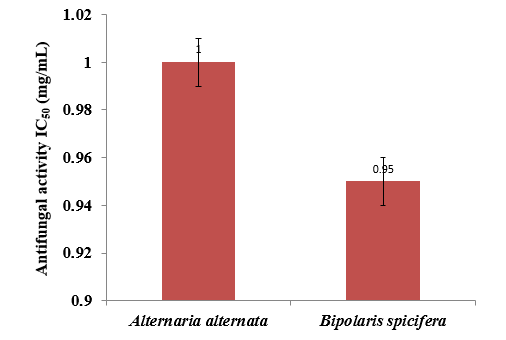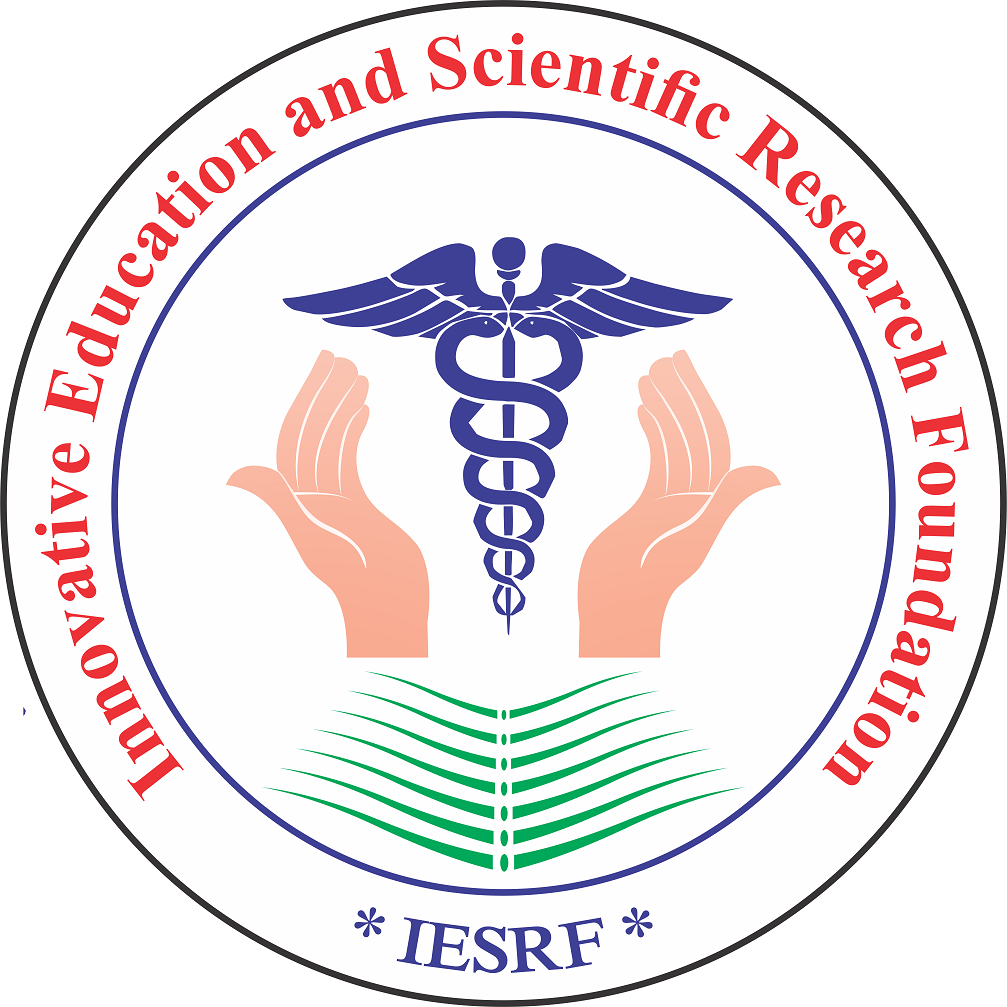- Visibility 120 Views
- Downloads 45 Downloads
- DOI 10.18231/j.ijpca.2023.050
-
CrossMark
- Citation
Antifungal efficiency of amla leaves against Alternaria alternata and Bipolaris spicifera
- Author Details:
-
Vikas Sharma *
-
Arti Heer
-
Navneet Kour
-
Shivangi Sharma
Introduction
Embilica officinalis known as Indian gooseberry or aonla/amla, belonging to family Euphorbiaceae, is a medium- sized deciduous tree with gray bark / reddish wood and is native to Tropical Sourthern Asia, particularly India. Amla fruit is highly nutritious, is one of the richest sources of vitamin-C, amino acids and minerals and contains several chemical constituents like tannins, alkaloids and phenols (Srivasuki et al., 2012; Zhang et al., 2003). A number of chemical constituents from every part of the plant have been extracted and several systematic scientific studies are also being conducted regarding the efficacy of whole plant or its parts in different extract forms for the treatment of different diseases. (Sharma et al., 2009). Amla extracts revealed antibacterial / antifungal (Hussain et al., 2012), antioxidant (Golechha et al., 2012), cardio-protective (Bhattacharya et al., 2002), anthelmintic (Dwivedi et al., 2011) and anti-inflammatory (Mishra et al., 2004) properties. Pharmacological research reports on amla reveals its analgesic (Sharma et al., 2004), anti-tussive (Nosal et al., 2003), anti-atherogenic (Santosh et al ., 2013), adaptogenic (Muruganandam et al., 2002), cardio (Baliga et al., 2013), gastro (Chatterjee et al., 2011), nephro (Yokozawa et al ., 2007), neuro-protective (Vasudevan et al., 2007) and anticancer (Madhuri et al., 2008) properties. Amla is also reported to possess chemopreventive (Krishnaveni et al., 2012) radio (Adil et al., 2010), chemo (Deep et al., 2005) and immunomodulatory (Varadacharyulu et al., 2009), free radical scavenging (Prakash et al., 2012) antioxidant, (Nripendranath et al., 2010), anti-inflammatory, (Santoshkumar et al., 2013) anti-mutagenic activities. Fungal diseases are a major cause of mobidity and mortality worldwide and pathogenic fungi are the main infectious agents in plants causing alterations during developmental stages including post-harvest.
|
Pathogen a |
Antifungal activity IC50 (mg/mL) |
|
|
MeOH |
|
Bipolaris spicifera |
0.95±0.019 |
|
Alternaria alternata |
1± 0.02 |



Materials and Methods
Preparation of extracts
Fresh leaves of amla were identified and collected from Herbal Garden, Sher-e-Kashmir University of Agricultural Sciences and Technology of Jammu (SKUAST-J). The freshly collected leaves were shade dried and ground into powdered form. The powdered dried leaf material was then extracted with organic solvent at room temperature to obtain extract for bioevaluation. The methanolic extract was prepared by percolating the dried ground plant material (100 g) with 99 per cent methanol that was evaporated using rotary vacuum evaporator.[1], [2], [3], [4], [5], [6], [7], [8]
Determination of antifungal activity by poisoned food technique
Different concentrations of test component (extract) were prepared in sterilized potato dextrose agar and poured in 9 cm petri plates. After this, 5 mm bit of test fungus was inoculated in the center of the agar plate (mycelia surface of the bit was placed upside down) followed by incubation of petri plates at 26 0C. The extension diameter (mm) of hyphae from the center to the dish was measured at 24 h interval, till the growth of fungus in the plate without test component (control) reached the edge of the plates. The experiment was repeated thrice and results were expressed as average of three replicates (Guleria et al., 2013)
Fungal growth diameter in each plate containing concentrations of test component was determined to calculate per cent growth inhibition.
The antifungal indices was calculated as:
Antifungal index (%) = (1-Da/Db) ×100
Da = Diameter of growth zone in the experiment dish (mm)
Db = Diameter of growth zone in the control (mm)
Results and Discussion
To evaluate the antifungal activity of methanolic extract from amla leaves, two agriculturally important phytopathogenic fungi - Alternaria alternate and Bipolaris spicifera were selected. Results in the present study revealed that the amla leaves possess potential antifungal activity against two pathogenic fungal species. It is found that methanolic extract of amla inhibited the growth of the colonies of large number of fungal species. The antimicrobial efficacy of extract of amla was qualitatively assessed on the basis of inhibition zone. In literature, many medicinal plants indicated their strength through antimicrobial behavior that was endorsed with high concentration of flavonoids and alkaloids.[9], [10], [11], [12]
The results of the present study showed that the antifungal activity of amla against both the test pathogens with IC50 values were 1±0.02 and 0.96±0.019 mg/mL respectively. The search for antimicrobials from natural sources has received much attention and efforts have been put in to identify compounds that can act as suitable antimicrobials agent to replace synthetic ones. Phytochemicals derived from plant products serve as a prototype to develop less toxic and more effective medicines in controlling the growth of micro-organism. These compounds have significant therapeutic application against human pathogens including bacteria, fungi or virus. Numerous studies have been conducted with the extracts of various plants, screening antimicrobial activity as well as for the discovery of new antimicrobial compounds.[13], [14], [15], [16] Therefore, medicinal plants are finding their way into pharmaceuticals, neutralceuticals and food supplements. Further, research has to be conducted to find out the possibility of this medicinally important plant as a potent antimicrobial drug and for other pharmacological properties to develop as cost effective formulation.
Conclusion
To conclude, many of the phytochemicals found in this particular plant proved to have potential antimicrobial properties, which has to further investigated. Complete purification and identification of the biologically active compounds might help in understanding the mechanism of action and thereby to formulate a new potent drug.
Source of Funding
None.
Conflict of Interest
None.
References
- M Golechha, J Bhatia, D Arya. Studies on effects of Emblica officinalis (Amla) on oxidative stress and cholinergic function in scopolamine induced amnesia in mice. J Environ Biol 2012. [Google Scholar]
- G Deep, M Dhiman, AR Rao, RK Kale. Chemopreventive potential of Triphala (a composite Indian drug) on benzo(a)pyrene induced fore stomach tumorigenesis in murine tumor model system. J Expe Clin Cancer Res 2005. [Google Scholar]
- G Dwivedi, AA Noorani, D Rawal, H Patidar. Anthelmintic activity of Emblica officinalis fruit extract. Int J Pharma Res Dev 2011. [Google Scholar]
- MS Baliga, AN Prabhu, DA Prabhu, AR Shivashankara, A Abraham, PL Palatty. ntidiabetic and Cardioprotective Effects of Amla (Emblica officinalis Gaertn) and its Phytochemicals. Bioactive Food Dietary Interven Diab 2013. [Google Scholar] [Crossref]
- A Chatterjee, S Chattopadhyay, K Sandip. Biphasic Effect of Phyllanthus emblica L. Extract on NSAID-Induced Ulcer: An Anti-oxidative TrailWeaved with Immunomodulatory Effect. Evid Based Complemen Alter Med 2011. [Google Scholar]
- SK Bhattacharya, A Bhattacharya, K Sairam, S Ghosal. Effect of bioactive tannoid principles of Emblica officinalis on ischemia-reperfusion-induced oxidative stress in rat heart. Phytomedicine 2002. [Google Scholar]
- M Krishnaveni, S Mirunalini. Chemopreventive efficacy of Phyllanthus emblica L. (amla) fruit extract on 7,12- dimethylbenz(a)anthracene induced oral carcinogenesis - A dose-response study. Environ Toxicol Pharmacol 2012. [Google Scholar]
- MM Hussain, MM Mazumder, K Hossen, SMM Tanmy, TT Rashid. In vitro studies on antibacterial and antifungal activities of Emblica officinalis. Int J Pharma Sci Res 2012. [Google Scholar]
- LC Mishra. . Scientific basis of Ayurvedic therapies 2004. [Google Scholar]
- AV Muruganandam, V Kumar, S Bhattacharya. Effect of poly herbal formulation, EuMil, on chronic stress-induced homeostatic perturbations in rats. Indian J Experimen Biol 2002. [Google Scholar]
- G Nosal, J Mokry, KM Hasan. Antitussive activity of the fruit extract of Emblica officinalis Gaertn, (Euphorbiaceae). Phytomedicine 2003. [Google Scholar]
- S Madhuri. Studies on Oestrogen Induced Uterine and Ovarian Carcinogenesis and Effect of ProImmu in Rats (PhD Thesis). 2008. [Google Scholar]
- J Santoshkumar, MS Devarmani, M Sajjanar, MS Pranavakumar, PA Dass. ) study of Anti-inflammatory activity of fruit of Emblica officinalis (Amla) in Albino rats. MedicaInnovatica 2013. [Google Scholar]
- F Sharififar, GD Nudeh, M Mirtajaldini. Major flavonoids with antioxidant activity from Teucrium polium L.. Food Chem 2009. [Google Scholar]
- J Santoshkumar, S Manjunath, MS Pranavkumar. A study of antihyperlipidemia, hypolipedimic and anti-atherogenic activity of fruit of Emblica officinalis (amla) in high fat fed Albino Rats. Int J Med Res Health Sci 2013. [Google Scholar]
- H Bibhabasu, S Rhitajit, B Santanu. Comparative study of the antioxidant and reactive oxygen species scavenging properties in the extracts of the fruits of Terminaliachebula, Terminaliabelerica and Emblica officinalis. BMC Complemen Alter Med 2010. [Google Scholar]
How to Cite This Article
Vancouver
Sharma V, Heer A, Kour N, Sharma S. Antifungal efficiency of amla leaves against Alternaria alternata and Bipolaris spicifera [Internet]. Int J Pharm Chem Anal. 2023 [cited 2025 Sep 12];10(4):303-305. Available from: https://doi.org/10.18231/j.ijpca.2023.050
APA
Sharma, V., Heer, A., Kour, N., Sharma, S. (2023). Antifungal efficiency of amla leaves against Alternaria alternata and Bipolaris spicifera. Int J Pharm Chem Anal, 10(4), 303-305. https://doi.org/10.18231/j.ijpca.2023.050
MLA
Sharma, Vikas, Heer, Arti, Kour, Navneet, Sharma, Shivangi. "Antifungal efficiency of amla leaves against Alternaria alternata and Bipolaris spicifera." Int J Pharm Chem Anal, vol. 10, no. 4, 2023, pp. 303-305. https://doi.org/10.18231/j.ijpca.2023.050
Chicago
Sharma, V., Heer, A., Kour, N., Sharma, S.. "Antifungal efficiency of amla leaves against Alternaria alternata and Bipolaris spicifera." Int J Pharm Chem Anal 10, no. 4 (2023): 303-305. https://doi.org/10.18231/j.ijpca.2023.050
